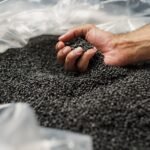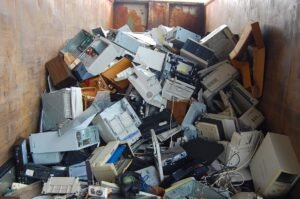What's water worth?
For a person, it's priceless and essential to survival.
But for industries across the globe, water is deeply undervalued, leading to irresponsible usage and pollution that can harm humans and animals alike, according to a report released by Ceres, a Boston-based nonprofit focused on sustainability.
"If we're misvaluing water, then we're bound to be mismanaging it," said Betty Yee, California state controller and a reviewer of the report.
The report, two years in the making, draws from nearly 200 scientific studies, government documents and white papers to assess myriad threats to the world's waters. It paints a picture of a planet with deep problems, ranging from dwindling supplies of groundwater to oceans overloaded with microplastics, lakes choked with algae and waterways contaminated by mineral mining booms.
Half of all river basins across the world are now "severely affected" by water diversion projects, which can exacerbate drought conditions and lead to human conflict, the report says. About the same percentage of lakes and reservoirs in Asia, Europe and North America also show eutrophication, an excess of nutrients that can lead to algae blooms and ecosystem collapse.
While many such problems are tied directly to nearby human activity, global climate change is also acting as a "threat multiplier," the report says. Increasing air temperatures are melting ice sheets and glaciers, exacerbating droughts and otherwise throwing off water cycles that human populations rely upon for drinking water, agriculture and even powering their homes.
Last year, a hydropower plant on California's Lake Oroville had to shut down for the first time since its opening in 1967 because of low reservoir levels, the report says. Elsewhere in the state, millions of acres of crop land have gone unplanted in recent years because of groundwater depletion.
The heavy withdrawal of groundwater in India, which uses more than any other country, has led to decreases in yields of wheat, rice and maize, and they could fall by 68% in some regions by 2025.
In Chile and China, the mining of metals like lithium for next-generation batteries to power electric cars requires up to 56% more water than what was used for traditional batteries, stressing local groundwater supplies. Meanwhile, the recycling of lead-acid batteries in Southeast Asia, Africa and Central and South America is contaminating water supplies and putting almost 1 million people at high risk of lead pollution, the report says.
Humans have long believed water supplies limitless and relied on dilution to resolve pollution. But according to Kate Brauman, associate director of the Global Water Security Center at the University of Alabama, humanity has surpassed those luxuries and now must rework the way it values and uses water.
"There's no free lunch with this anymore," Brauman said.
Ceres proposes market-based solutions to the problem by encouraging investors to pressure companies into thinking about how they affect water supplies and pollution and whether their practices are sustainable.
"Industry—from food production to mining, apparel manufacturing to high-tech—collectively is the single largest user and influencer of water resources," the report notes.
According to a Barclay's report cited by Ceres, food and beverage companies alone could face a $200 billion impact from water scarcity and pollution risks. Another estimate analyzing 3,000 companies across multiple sectors cited by Ceres pegged the financial risk at $300 billion if dangers are not mitigated.
Activities at risk can include operations—water shortages could hinder the extraction of $50 billion in mining materials by 2030—as well as recreation, such as an estimated $2.2 billion in lost tourism dollars in the U.S. each year because of toxic algae blooms along lakes and coastlines.
But, the Ceres report adds, solutions are often near at hand. By reusing water, implementing smarter management of crops and lands, and developing new technologies and materials, companies can mitigate the damage.
Agriculture greatest burden, but threats range
Ceres identified seven key sectors that can cause water shortages and pollution: food production, consumer goods, energy generation, health care, materials, technology and utilities.
But agriculture plays the largest role in water use, accounting for about 70% of worldwide consumption, the report notes, while all other industrial sectors account for about 19%.
Within food production, crop irrigation requires the most water and is leading aquifers to dry out. A 2019 study cited in the report estimates that by 2050, 42% to 79% of watersheds where groundwater is pumped "could surpass ecological tipping points without better water management."
Agriculture also plays a leading role in the pollution of water. Excess nutrients from fertilizers and manure run into waterways, leading to algae blooms and decreased oxygen levels that can create ecological "dead zones" in rivers, lakes and oceans.
But other industries such as plastics and health care are also polluting water supplies and accumulating in the food chain, ultimately reaching humans and risking toxic health effects.
Fourteen million tons of plastics are now reaching the oceans each year, the equivalent of eight garbage bags full of trash for every foot of coastline worldwide. Medicines passing through human waste and the use of antibiotics for agriculture have increased pharmaceutical-related water risks ten- to twentyfold over the past several decades, the report says, increasing the likelihood of new antibiotic-resistant bacteria and harming human reproduction.
How water resources are divvied up and managed can also exacerbate natural drought and flood conditions. That, in turn, can lead to supply chain disruptions that ripple across the globe.
Over the course of several months in 2021, the report says, extreme flooding in China cut off coal deliveries and led to widespread power outages, mudslides in Europe disrupted rail traffic essential for steelmaking, and Taiwan's worst drought in 50 years deepened a shortage of semiconductors used across the world.
An economic report released by the Biden administration this week warned that such "climate-induced weather emergencies" will continue to disrupt supply chains even as the world emerges from the COVID-19 pandemic.
"As networks become more connected, and climate change worsens, the frequency and size of supply-chain-related disasters rises," the administration said.
The Ceres report lays out a 10-year "action plan" for industries and companies to address water-related challenges. Work should begin with an assessment of each company's water use, identifying the watersheds from which it draws and the overuse or pollution challenges they face.
Once problems are identified, companies should then work to mitigate harms by creating tangible targets and implementing solutions to obtain them, such as reusing water, using safer chemical alternatives, investing in public work projects for nearby communities, and working with suppliers to further reduce their water footprint.
The Ceres report recommends education and buy-in at the corporate leadership and boardroom level. But Brauman, the University of Alabama water expert, said that because of the unique circumstances of individual facilities, expert consultation is best.
"It really depends where you are, and what you're manufacturing, and what your processes are," Brauman said. "And you need an expert to really work on that with you."
In May, Ceres plans to launch an initiative aimed at sharing its findings with large, institutional investors like state pension funds, said Kirsten James, senior director of Ceres' water program. Ultimately, the nonprofit hopes enough will advocate for change in the companies in which they hold shares.
"Investors have a very big leverage point to make the change that we're looking for," James said.
Source: =”https://phys.org/news/2022-04-dead-rivers-polluted-oceans-industry.html” target=”_blank” rel=”noopener”>phys.org














4 comments
https://www.ecobij.nl
Hey! Do you know if they make any plugins to assist with
SEO? I’m trying to get my website to rank for some targeted keywords but I’m
not seeing very good success. If you know of any please share.
Appreciate it! You can read similar text here:
Wool product
Barrett
Hi there! Do you know if they make any plugins to help with SEO?
I’m trying to get my site to rank for some targeted keywords but I’m not seeing very good success.
If you know of any please share. Appreciate it! You can read similar art
here: Code of destiny
Ivette
I am extremely inspired along with your writing abilities as neatly as with the format on your weblog. Is this a paid subject or did you customize it yourself? Either way keep up the nice high quality writing, it’s uncommon to look a great blog like this one today. I like recyclean.in ! It’s my: TikTok ManyChat
Argentina
I am extremely impressed with your writing talents and also with the layout in your weblog. Is that this a paid subject matter or did you modify it your self? Either way keep up the excellent quality writing, it’s rare to look a great blog like this one these days. I like recyclean.in ! Mine is: Leonardo AI x Midjourney